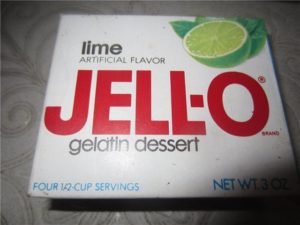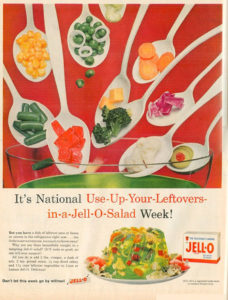
“J E L L O!” the letters, sung to a rising scale, were a frequent childhood memory for me from TV commercials. Indeed, we were big Jell-O fans in the Enderland house in the 60’s.
Mom loved it because it was inexpensive and simple to make. Dad loved it because it was easy for a dentures-wearer to consume. And I loved it because of that chewy, rubbery layer that would form at the bottom of the casserole tray that mom would typically pour the hot mixture into before popping it into the fridge, or icebox as we called it back then.
Of course, it would always be cherry Jell-O, with banana slices added. I must have eaten two or three hundred pounds of the stuff as I grew up in the 60’s.
Another variant that mom would create was orange Jell-O with a can of fruit cocktail thrown in. Good stuff.
We inhaled lots of the sweet gelatinous substance despite rumors going around school as to its source: cow hooves.
I would roll my eyes at such allegations. How could something so sweet and irresistible come from such a disgusting source? I mean, sure, we had heard that Elmer’s glue was a product of horse hooves, but that only made sense. After all, it was not something you would eat (although a kid or two in grade school did try it, as I recall). But delicious Jell-O must surely have originated from a formula with nothing more sinister than lots of sugar, syrup and the like.
Jell-O first appeared in 1895, when a fellow who manufactured patent medicine who had the rather unlikely name of Pearl B. Wait purchased the patent for the gelatinous dessert from industrialist Peter Cooper. Wait and his wife didn’t have much luck selling Jell-O, so they sold the rights to entrepreneur and high school dropout Frank Woodward.
Woodward was within inches of selling the rights to the poor-selling product to his plant superintendent for 35 bucks when the product suddenly took off.

Sales rose steadily, as Jell-O became viewed as a sophisticated dessert for the beautiful people. Eventually, the company that made Jell-O became food mega giant General Foods.
By the 70’s, Bill Cosby became a spokesman for Jell-O products and kept that position for thirty years.
Other gelatin manufacturers would try to compete with Jell-O, but the only one that I remember was called Mr, Wiggles or something like that. Jell-O has managed to thoroughly dominate a market without having its extremely familiar brand name (99% of Americans are familiar with it) turn into a generic term, as happened with Aspirin, for example.
You either loved or hated the rubbery layer that would form at the bottom of the container. My wife couldn’t stand it. I thought it was the creme de la creme. Oh well, she won’t eat raw oysters either.
Of course, nowadays we know that gelatin does indeed come from repellent sources, including cowhides, pig skin, and bones. But, we simply put it out of our minds as we enjoy a parfait, a Jell-O shot, or simply a casserole full of the cherry-flavored variant with banana slices thrown in for good measure, just like mom used to make.